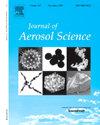Effects of fuel sulfur content and nvPM emissions on contrail formation: A CFD-microphysics study including the role of organic compounds
IF 2.9
3区 环境科学与生态学
Q2 ENGINEERING, CHEMICAL
引用次数: 0
Abstract
Aviation-induced contrails impact the climate significantly by altering atmospheric properties at cruise altitudes. Understanding the formation and evolution of ice crystals in aircraft engine plumes is essential for improving contrails prediction and mitigating their climate effects. This study introduces an innovative CFD-microphysics coupling methodology to simulate ice crystal formation in the near field of a turbofan engine plume. A 2.5D axisymmetric Eulerian-Lagrangian framework was employed, integrating gas-phase chemistry (60 reactions with 22 reactive species) and a detailed microphysical model. The model accounts for soot surface activation, condensation of organic vapors and sulfur species (H2SO4 and SO3), as well as freezing and deposition processes. Results demonstrate that colder ambient temperatures (e.g., 212 K) enhance water supersaturation, accelerating ice crystal formation and growth, with soot-derived ice crystals reaching mean radii of up to 680 nm. Lower FSC increase the number of ice crystals due to the accompanying higher water supersaturation, while higher FSC promote larger ice crystals through enhanced condensation on soot particles. Organic compounds were shown to play a critical role in soot particle activation and growth, particularly under high FSC and lower temperature conditions, where they dominate the surface composition as compared to sulfur species. The soot emission index significantly influences the ice crystal number and size, with a soot emission index of 1.38 × 1013 #/kg-fuel producing the largest soot-derived ice particles due to reduced competition for available moisture. Hydrates and volatile particles exhibit peak concentrations of 1013 #/cm3 under high FSC, reflecting the role of sulfuric acid in their growth.
燃料硫含量和nvPM排放对尾迹形成的影响:包括有机化合物作用的cfd微物理研究
航空引起的尾迹通过改变巡航高度的大气特性而对气候产生重大影响。了解飞机发动机羽流中冰晶的形成和演变对于改善尾迹预测和减轻其气候影响至关重要。本文介绍了一种创新的cfd -微物理耦合方法来模拟涡扇发动机羽流近场冰晶的形成。采用2.5D轴对称欧拉-拉格朗日框架,整合气相化学(60个反应,22种反应物质)和详细的微物理模型。该模型考虑了烟尘的表面活化、有机蒸汽和硫化物(H2SO4和SO3)的冷凝以及冻结和沉积过程。结果表明,较低的环境温度(例如,212 K)增强了水的过饱和,加速了冰晶的形成和生长,烟灰衍生的冰晶的平均半径可达680 nm。较低的FSC会增加冰晶的数量,这是由于水的过饱和度较高,而较高的FSC会通过增强烟灰颗粒的凝结来促进冰晶的变大。有机化合物在烟灰颗粒的活化和生长中起着关键作用,特别是在高FSC和低温条件下,与硫相比,它们在表面组成中占主导地位。烟灰排放指数显著影响冰晶数量和大小,烟灰排放指数为1.38 × 1013 #/kg-燃料时,由于有效水分竞争减少,产生的烟灰衍生冰晶最大。高FSC下水合物和挥发性颗粒的浓度峰值为1013 #/cm3,反映了硫酸对其生长的作用。
本文章由计算机程序翻译,如有差异,请以英文原文为准。
求助全文
约1分钟内获得全文
求助全文
来源期刊

Journal of Aerosol Science
环境科学-工程:化工
CiteScore
8.80
自引率
8.90%
发文量
127
审稿时长
35 days
期刊介绍:
Founded in 1970, the Journal of Aerosol Science considers itself the prime vehicle for the publication of original work as well as reviews related to fundamental and applied aerosol research, as well as aerosol instrumentation. Its content is directed at scientists working in engineering disciplines, as well as physics, chemistry, and environmental sciences.
The editors welcome submissions of papers describing recent experimental, numerical, and theoretical research related to the following topics:
1. Fundamental Aerosol Science.
2. Applied Aerosol Science.
3. Instrumentation & Measurement Methods.
 求助内容:
求助内容: 应助结果提醒方式:
应助结果提醒方式:


